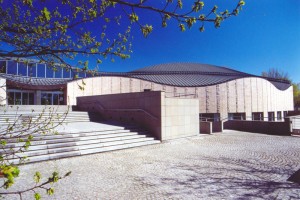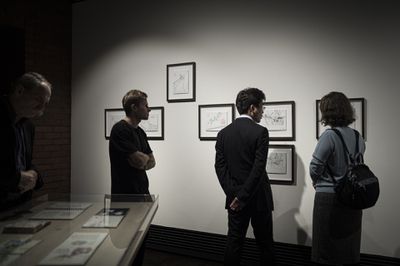posted on
06 Mar 2012
Manggha Museum of Japanese Art and Technology, Poland


The Manggha Museumof Japanese Art and Technology in Krakow is the product of the idea of two visionaries: Wajda and Jasieński. During its 15 years of activity, the institution created by Andrzej Wajda for Feliks Jasieński’s collection has been putting its founder’s vision into practice - the vision of a place where the Polish people can getto know Japan better, and where the magnificient Japanese tradition is presented side by side with that nation’s technological achievments.This cultural institution combines two functions: that of a museum and that of an active cultural centre. Based in a modern, welcoming building, the museum consistently implements new methods and forms of activity, including interdisciplinary one. In addition to exhibitions on art and technology, the museum is a venue for theatre performances, film showings, workshops, lectures, and scholarly conferences. In its wide and varied range of activities promoting Japanese culture in Poland, its main emphasis has been on education and the dissemination of art. History of the Manggha Museum - The Founders of the Manggha Centre/Museum are Andrzej Wajda and Krystyna Zachwatowicz, and the architects of the museum building, Arata Isozaki with his wife, Aiko Miyawaki. The beginnings of the Manggha Museum is found in the second half of the 19th century, when Feliks Jasieński, an eccentric art lover, fascinated with Japanese art, accumulated a huge collection comprising wood engravings, costumes and outfits, fabric, weapons and military accessories. Japanese art, which he discovered and propagated, had freshness and power which also enthralled Krakow’s artists. The influence Japanese art exerted on their paintings gained the name Japonism as a movement in Polish arts at the end of the 19th and at the start of the 20th century. In the 1920s, Jasieński donated his collection to the National Museum in Krakow, and it was kept in the storage rooms for many years, available only to researchers and preservation specialists, and seldom exhibited due to the lack of adequate exhibition spaces. In 1944, in Krakow under Nazi German occupation, a part of the collection was exhibited in the Cloth Hall gallery and that was when the nineteen-year-old Andrzej Wajda saw it. The vision of the world that it offered spoke to the young artist with unusual power, opening up new horizons before him. Years later in 1987, when receiving his Kyoto Prize in Japan, granted to him in recognition of his lifetime achievements in film and theatre, the director reminisced about that the exhibition: 'I had never before seen so much brightness, light, order, and such a sense of harmony – that was my first encounter with real art. The feelings and raptures experienced when we are young are the strongest in our lives. This is why, receiving the Kyoto Prize, I look back on that moment and wish for others to be as happy as I was back then, gazing for the first time at the masterpieces of ancient Japanese art.' Andrzej Wajda and his wife, Krystyna Zachwatowicz, decided to donate the Kyoto Prize to the construction of a building in Krakow where Feliks Jasieński’s collection could be exhibited, but also one where contemporary Japanese art and technology could be presented. The initiative was joined by Krakow city and voivodeship government authorities, by providing the Foundation with a plot to build the Centre at a prestigious location on the banks of the Vistula River, right across from the Royal Castle on Wawel Hill. The Foundation received support in the form of advice and much kindness from the Japanese Embassy, headed by Ambassador Nagao Hyodo. In Japan, tens of thousands of donors raised funds for the Centre. The East Japan Railway Workers’ Union, headed by President Akira Matsuzaki, raised around one million dollars for the Foundation. After 15 months, on 30 November 1994, the Centre of Japanese Art and Technology ”Manggha” was opened in Krakow. The design was created by a celebrated Japanese architect, Arata Isozaki, and presented to the Foundation as a gift. The facility was designed as a place of encounter of two traditions and cultures – on a both historical and contemporary, artistic and technological plane. The function of the building is that of a museum and a venue for exhibitions. It has a complex of multi-purpose spaces for conferences, concerts and theatre productions, also storage rooms, offices and historic preservation studios. The museum’s exhibition spaces are filled with the Japanese art forming Feliks Jasieński’s valuable collection, part of the Far East Art Collection owned by the National Museum in Krakow, and also temporary exhibitions of Japanese art and technology.
We are really happy that Feliks Jasieński’s magnificent collection has found a worthy home. This is a great merit on the part of all the Japanese friends of the Kyoto-Krakow Foundation, who managed to raise the funds for this cause, and without whose help the Centre of Japanese Art and Technology could not have been erected. This was possible only after Poland regained independence in 1989 and only in Krakow – a city of tradition – enriched today with the beautiful building designed by Arata Isozaki, whose creation was also the goal of great and energetic efforts on the part of the Krakow City authorities. After nearly a hundred years, since the time when Feliks Jasieński’s collection was accumulated, Japan is not merely a country of fascinating art to us. Today, we encounter the products of Japanese industry almost every day, products which inspire interest in the country that made them. This is the reason why we want the collection of old Japanese art to be accompanied at the Manggha Centre by exhibitions of contemporary technology. We think that this surprising encounter of old art with today’s Japanese technology – which today exerts an influence on the direction of the world’s development that is not smaller than the influence Hokusai or Utamaro had on European art at the end of the 19th and the start of the 20th century – will show Polish people a Japan resting with its two wings on tradition and modernity, which takes off, starting a flight into the future of the 21st century like a giant bird.Andrzej Wajda and Krystyna Zachwatowicz
Similar content
posted on
17 Feb 2020
posted on
24 Mar 2019
posted on
02 Mar 2012
posted on
08 Jun 2015
posted on
07 Mar 2015
posted on
23 Jun 2015
